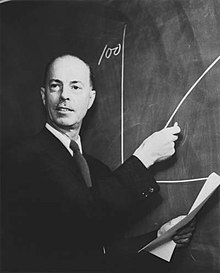Colin Munro MacLeod
| Colin Munro MacLeod | |
|---|---|
 |
|
| Born |
January 28, 1909 Port Hastings |
| Died | February 11, 1972 (aged 63) |
| Institutions | International Centre for Diarrhoeal Disease Research, Bangladesh |
| Known for | Avery–MacLeod–McCarty experiment |
Colin Munro MacLeod (January 28, 1909 – February 11, 1972) was a Canadian-American geneticist. He was one of a trio of scientists who discovered that deoxyribonucleic acid, or DNA is responsible for the transformation of the physical characteristics of bacteria, which subsequently led to its identification as the molecule responsible for heredity.
MacLeod was born in Port Hastings, Nova Scotia, Canada, one of eight children of a schoolteacher and a Scottish Presbyterian minister. He entered McGill University at the age of 16 after skipping three grades in primary school, and completed his medical studies by age 23.
In his early years as a research scientist, MacLeod, with Oswald Avery and Maclyn McCarty, demonstrated DNA is the molecule responsible for bacterial transformation — and in retrospect, the physical basis of the gene. In 1941, Avery and MacLeod separated a crude extract from smooth (‘S’) strains of Streptococcus pneumoniae, the most common cause of bacterial pneumonia. The S strain extract could convert the more benign rough (‘R’) strains of pneumococci into the disease-causing S form. Later that year, McCarty joined the Avery laboratory, and in 1942, the group began to focus on DNA as the elusive ingredient in the S strain extract as the factor responsible for transformation of R pneumococci into S pneumococci. By early 1943, Avery, MacLeod, and McCarty had shown that DNA was the transforming factor, and in February 1944, published the first of a series of scientific papers in the Journal of Experimental Medicine demonstrating that DNA was the transforming principle. Subsequent experiments confirmed DNA as a universal bearer of genetic information. However, despite the enormous scientific importance of this work, which became known as the Avery–MacLeod–McCarty experiment, the trio did not win a Nobel Prize for their discovery.
MacLeod was diverted from research on Streptococcus pneumoniae and DNA to health and science issues related to the Second World War. At the time, microbial diseases such as typhus fever, malaria, and pneumonia posed significant threats to the health of U.S. military personnel. During the war, MacLeod was one of many university-based scientists and physicians who advised the federal government on medical matters “when asked.” In 1941, he was appointed Chairman of the Department of Microbiology at New York University School of Medicine, and worked as a consultant to the U.S. Secretary of War. He became an official member of the Army Epidemiological Board, which in 1949 was enlarged to include all the armed forces and renamed the Armed Forces Epidemiological Board. MacLeod became president of the board in 1947, a position he held until 1955. The organization of the AFEB into twelve disease-related commissions foreshadowed the organization of the US-Japan Cooperative Medical Science Program into its disease-related panels.
...
Wikipedia
